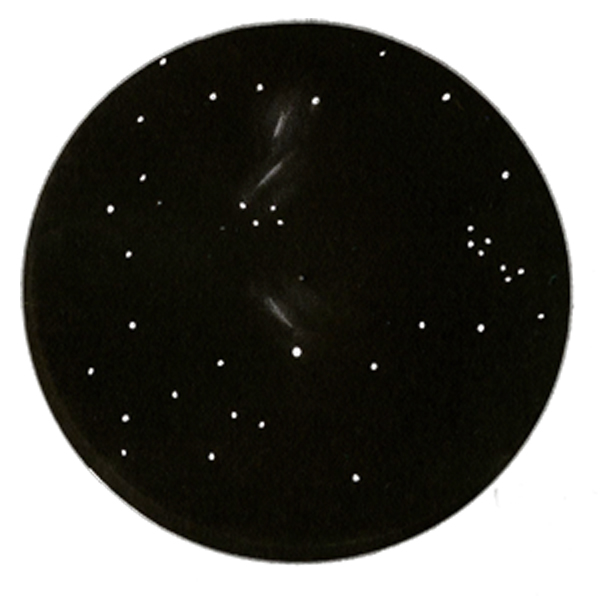About the Deep-Sky Gems
 During a lifetime of comet hunting David Levy has swept up many unique and interesting deep-sky objects and through this observing program he shares with us 154 of his Deep Sky Objects (Prometheus Books, New York 2005). Leo Enright (1943–2009) invested a great deal of time on the project, selecting objects that did not overlap with other RASC observing programs. The certificate has been awarded since 2013.
During a lifetime of comet hunting David Levy has swept up many unique and interesting deep-sky objects and through this observing program he shares with us 154 of his Deep Sky Objects (Prometheus Books, New York 2005). Leo Enright (1943–2009) invested a great deal of time on the project, selecting objects that did not overlap with other RASC observing programs. The certificate has been awarded since 2013.
Many deep-sky objects in the list are from the NGC and Index Catalogue (IC) but there are also unique objects, such as Levy 384, Tombaugh’s Cluster, and a dust field. The Deep-Sky Gems list was first published in the RASC Observer's Handbook in 2008. (Drawing of IC 2197/2196/2194 by Melody Hamilton)
Below is an overview of the Deep-Sky Gems observing list:
| GEM Objects | Number | Notes |
| Open Clusters | 14 | Including the overlooked naked-eye open cluster NGC 752, Tombaugh’s Cluster, and the Christmas Tree Cluster in Monoceros. |
| Globular Clusters | 14 | “Intergalactic Wanderer” in Lynx and globular cluster NGC 7006 in Delphinus. |
| Bright Nebulae | 7 | Unusual objects such as NGC 1333, the Embryo Nebula, and NGC 7023, the Iris Nebula, along with other “weird” nebulae. Some are associated with nearby star clusters. |
| Planetary Nebula | 1 | This large and bright Fornax planetary deserves to be better known. |
| Galaxies | 112 | Large and small, round and elongated, there is a great variety of galaxies, spiral, elliptical, and unusual. |
| Double Quasar | 1 | This is the remarkable double quasar known to act as a gravitational lens +561A/B in Ursa Major |
| Nebula-Dust-Field | 1 | NGC 2174 known as the Monkey Head Nebula |
| Galaxy Clusters | 3 |
IC and Arp clusters visible in medium sized scopes.
|
| Asterism | 1 | This is a very special asterism that has gained recognition in observational literature as "Levy 384" in Puppis |
| Total | 154 |
|---|
RASC Deep-Sky Gems Certificate
Observing the Deep-Sky Gems is an excellent project for those who have completed their Messier and Finest NGC Certificates and are looking for another visual observing program. The official list can be found in the RASC Observer's Handbook. At least a 20-cm (8-inch) telescope is recommended for tackling the list, but an instrument with an aperture in the 40-cm (16-inch) range will be needed to satisfactorily observe the quasar. A nebular filter will assist in observing most of the nebulae. Several Deep-Sky Gems may be observed in smaller instruments or without optical aid, so that virtually anyone can begin this project without a trip to the scope shop. Nebular filters will assist in the observation of faint glowing clouds of gas, but note that reflection nebulae do not benefit from such filtration.
You may observe the Deep-Sky Gems in any order. RASC members only may apply for a certificate.
Use the generic application form (PDF, 185 KB) for this visual certificate application. The form has a language of choice option for the Certificate. Indicate your home affiliated RASC centre or "National" or "Unattached" if not associated with a specific centre.
Do not email large files or multiple files to the Observing Committee chair. Ask about our new Uploader Service!
This Observing Program is designed to be an INDIVIDUAL EFFORT. When you complete the program and apply for your certificate, you will have met these requirements: you located the object yourself, made your own observation at the eyepiece, kept your own log book or pre-programmed observing forms, and then applied for your certificate on your own merit. Enjoy your journey through this program!
Contact the Observing Committee Chair: observing AT rasc.ca
Resources
A couple of recommended resources are provided to help you tackle the Deep-Sky Gems Certificate program.
-
Deep Sky Objects - by David H. Levy, The Best and Brightest from Four Decades of Comet Chasing.
-
Observing (bookmark) list files for Stellarium are available at the RASC Toronto Centre web site.
-
A YouTube video on advanced observing.
- Log in to post comments
